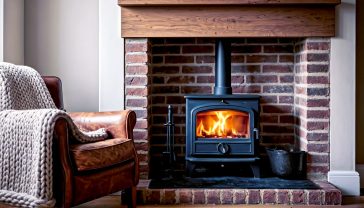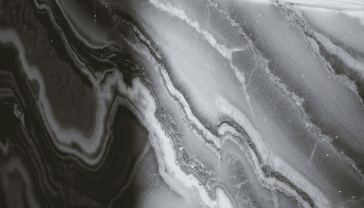Granite Worktops: The Jewel of Your Kitchen
Your complete guide to granite worktops. Discover the history, costs, colours, and care tips to help you choose the perfect stone for your British kitchen.

This post may contain affiliate links. If you make a purchase through these links, we may earn a commission at no additional cost to you.
Picture your dream kitchen. It’s the heart of your home, isn’t it? It’s where you brew that first cup of tea in the morning, where the kids do their homework, and where friends gather over a bottle of wine. Now, what’s the one feature that pulls it all together, that feels solid and timeless under your hands? For many, the answer is a granite worktop.
It’s more than just a place to chop veg. A granite worktop is a slice of the Earth’s history, formed over millions of years, deep underground. It’s a statement of quality, a promise of durability, and a thing of natural beauty. But choosing one can feel like a massive decision. What colour do you pick? How much does it cost? And how do you stop it from getting stained by that stray splash of curry?
Don’t worry. We’re going to break it all down. Think of this as your complete guide to everything you’ve ever wanted to know about granite worktops. We’ll journey from the fiery heart of a volcano to the final polish in your kitchen, covering everything from the different types of granite you can buy in the UK to how to look after it. By the end, you’ll know exactly why this remarkable stone has become the jewel of the British kitchen.
What on Earth is Granite? A Peek into the Planet’s Kitchen
Before it becomes a swanky worktop, granite has a pretty dramatic backstory. It’s a story that involves volcanoes, immense pressure, and a very, very long wait.
A Recipe Billions of Years in the Making
Imagine a giant, bubbling pot of molten rock deep beneath the Earth’s surface. This fiery soup is called magma. Over countless millennia, this magma slowly cools down and hardens. As it cools, different minerals start to form crystals, like sugar crystals forming in a jar of honey. It’s this slow cooling process that gives granite its famously large, visible crystals. If the magma had cooled quickly, it would have formed a different rock, like basalt, which has tiny crystals.
So, granite is what geologists call an igneous rock, which is just a fancy way of saying it’s born from fire.
The Three Key Ingredients
Granite isn’t just one single thing; it’s a mix of different minerals. The main ones you’ll see are:
- Quartz: This is usually the milky white or greyish, semi-transparent mineral. It’s incredibly hard, which is what makes granite so tough and scratch-resistant. It’s the muscle of the worktop.
- Feldspar: This is the mineral that gives granite most of its colour. It can be pink, white, grey, or even blue. The type and amount of feldspar determine whether you get a slab of shimmering pearl or a deep, earthy red.
- Mica (or other dark minerals): These are the little black or silvery specks that glitter in the light. Often, this is a mineral called biotite. It adds depth and character to the stone.
The unique combination of these minerals in every single slab is why no two granite worktops are ever identical. Each one is a one-of-a-kind piece of natural art, with its own unique pattern of swirls, veins, and specks.
From Scottish Quarries to Global Kitchens: A Very British History
While granite is found all over the world, it holds a special place in British history. For centuries, we’ve been quarrying it from our own rugged landscapes and using it to build things that last.
The Granite City: Aberdeen’s Silver Stone
You can’t talk about British granite without talking about Aberdeen. Nicknamed “The Granite City,” its buildings famously sparkle in the sun because they’re made from locally quarried granite. From the 18th century, Aberdeen became a world leader in granite quarrying and masonry. The stone from places like Rubislaw Quarry wasn’t just used to build the city; it was exported across the globe. It was used to build the terraces of the Houses of Parliament and the iconic Forth Rail Bridge.
This wasn’t pretty, polished kitchen granite. This was tough, structural stuff, built to withstand the harsh Scottish weather. The men who worked these quarries were master craftsmen, and their skills laid the foundation for the stone industry we have today.
Cornish Granite: The Foundation of Landmarks
Down in the southwest, Cornwall also has a rich granite heritage. For centuries, Cornish granite was the go-to material for building lighthouses, like the famous Eddystone Lighthouse, and major London landmarks, including Tower Bridge and the Embankment.
The Industrial Revolution created a huge demand for this incredibly strong stone. It was used for everything from engine houses in tin mines to grand Victorian monuments. This history shows us that granite has always been trusted for its strength and permanence, long before it became a fashionable choice for kitchens.
The Modern Kitchen Revolution
So how did this industrial stone make its way into our homes? The idea of the luxury kitchen worktop is actually quite new. In the post-war era, kitchens were practical spaces, often with laminate or formica surfaces. It wasn’t until the 1980s and 90s, when home improvement became a national obsession, that people started wanting higher-end materials.
Granite from Italy, Brazil, and India began to be imported into the UK. New technologies made it easier to cut and polish large slabs, making it more affordable. Suddenly, this ancient, durable stone became the ultimate symbol of an aspirational kitchen. It represented a love of natural materials, a desire for quality, and a connection to something solid and real in a fast-changing world.
The Journey of a Worktop: From Quarry to Your Kitchen
Ever wondered how a massive chunk of rock from a mountain in Brazil ends up as the polished surface where you make your sandwiches? It’s a fascinating process that combines raw power with incredible precision.
Step 1: Blasting and Extracting the Blocks
The journey starts at a quarry, which is basically a giant, open-air mine. Granite is found in huge deposits all over the world, from India and China to Norway and Brazil.
Getting it out of the ground is a serious business. Huge blocks, some weighing over 20 tonnes (that’s heavier than three elephants!), are carefully extracted from the mountainside. This isn’t done with simple dynamite, as that would shatter the stone. Instead, a process called jet piercing or controlled blasting is used. Small holes are drilled into the rock, and a careful explosion creates a clean break, freeing the block without cracking it. These enormous, rough blocks are then lifted by massive cranes onto lorries, ready for the next stage.
Step 2: Slicing the Giant: The Gang Saw
The rough blocks are transported to a processing plant. Here, they meet the gang saw. This isn’t your average saw from B&Q. A gang saw is a colossal machine with multiple steel blades, sometimes over a hundred, all moving back and forth together.
Water and an abrasive grit (like sand) are constantly poured over the blades as they slice through the granite block. It’s a slow, noisy, and messy process. It can take several days for the saw to cut all the way through a single block. The end result is a set of raw slabs, usually around 2cm or 3cm thick, which is the standard thickness for a worktop.
Step 3: Polishing and Perfecting the Surface
At this point, the slabs are still dull and rough. They need to be polished to bring out their natural colour and pattern. This is done with a robotic polishing line. The slab moves along a conveyor belt under a series of rotating polishing heads.
These heads start with very coarse, diamond-tipped pads and gradually get finer and finer. It’s like sanding a piece of wood, but on an industrial scale. The final pads are incredibly fine, almost like felt, and they buff the surface to a high-gloss, mirror-like finish. This is the classic polished finish that most people associate with granite worktops.
Step 4: Templating and Fabrication: The Bespoke Touch
This is where your kitchen comes in. Once you’ve chosen your slab from a stone yard in the UK, a specialist fabricator will come to your home to make a template. They used to do this with thin strips of wood or plastic, but now it’s often done with a high-tech laser templating device. This creates a super-accurate digital map of your cabinets, including the exact positions for the sink, hob, and any taps.
This digital template is then sent to the workshop and loaded into a CNC (Computer Numerical Control) machine. This is a computer-guided cutting machine that uses a diamond-tipped blade or a high-pressure waterjet to cut the slab to the precise shape of your kitchen. It’s incredibly accurate, ensuring a perfect fit.
The fabricators then finish the edges (a process we’ll look at later) and cut out the holes for your sink and hob. Finally, the finished worktop is carefully loaded onto a van and brought to your home for installation. It’s a heavy job, often needing several people to lift it into place.
Choosing Your Granite: A World of Colour and Style
Walking into a stone yard can be a bit overwhelming. You’ll be faced with rows and rows of giant slabs, each with a different name and a completely unique pattern. How do you choose the right one for your kitchen? Let’s break down the options.
The Granite Rainbow: Popular Colours in the UK
Granite comes in an amazing array of colours, thanks to its varied mineral content. Here are some of the most popular choices you’ll find in British homes:
- Black Granite: This is the little black dress of the kitchen world – classic, sophisticated, and it goes with everything. Absolute Black from India is almost completely uniform, offering a sleek, modern look. Star Galaxy, also from India, is a deep black with tiny golden or coppery flecks of a mineral called bronzite, which sparkle like a night sky. It’s been a UK favourite for decades.
- White and Light Granite: White granite worktops create a bright, airy, and clean feel. They are perfect for smaller kitchens or for achieving a Scandinavian or minimalist look. Varieties like Kashmir White from India have a soft, snowy background with delicate grey and garnet-coloured specks. Be aware, though, that lighter granites can be more porous and may need more careful sealing to prevent stains.
- Grey Granite: A versatile and modern choice, grey is the perfect neutral. It can range from soft, silvery greys like Steel Grey to dramatic, dark charcoals with bold veining. It pairs beautifully with both modern, high-gloss cabinets and traditional, painted shaker-style kitchens.
- Brown and Gold Granite: These earthy tones bring warmth and a touch of luxury to a kitchen. Slabs like Baltic Brown from Finland have a distinctive circular pattern and a rich, chocolatey colour. They work wonderfully with wooden cabinets, creating a cosy, traditional feel.
- Exotic and Bold Colours: If you want your worktop to be a real showstopper, there are some incredible options out there. Blue Pearl from Norway has an iridescent, silvery-blue lustre that changes in the light. Some Brazilian granites have dramatic, flowing waves of green, blue, and gold that look more like a piece of abstract art than a rock.
Beyond the Polish: Choosing a Finish
The look and feel of your granite isn’t just about the colour. The surface finish also plays a huge role.
- Polished: This is the most common finish. It’s highly reflective, making the colours look rich and deep. It’s also the most practical finish as the polishing process closes up the pores of the stone, making it less absorbent and easier to clean. It’s the go-to choice for a classic, high-end look.
- Honed: A honed finish is smooth but not shiny. It has a matte, satin-like feel. This creates a softer, more contemporary and understated look. It can be great for hiding fingerprints and water spots. However, a honed surface is more porous than a polished one, so it needs to be sealed very diligently to protect it from stains.
- Leathered or Brushed: This finish is becoming increasingly popular. It has a soft sheen and a slightly textured, bumpy feel, a bit like leather. It’s created by brushing the slab with diamond-tipped bristles. A leathered finish is fantastic for hiding smudges and adds a unique, tactile quality to the worktop. It’s a great choice if you want something a bit different and very practical.
Don’t Forget the Edges!
The final detail to consider is the edge profile. This is the shape that’s cut into the edge of the worktop. It might seem like a small thing, but it can have a big impact on the overall style.
- Straight or Pencil Edge: A simple, clean, squared-off edge. It’s perfect for a modern, minimalist kitchen.
- Bevel Edge: A small, 45-degree cut along the top edge. It adds a touch of detail without being too fussy.
- Bullnose: A fully rounded edge. It’s a classic, soft look that’s safe for families with young children as there are no sharp corners.
- Ogee Edge: A more decorative, S-shaped curve. This is a very traditional and formal look, often seen in high-end, classic kitchens.
The Practicalities: Cost, Installation, and Getting it Right
So, you’ve fallen in love with a beautiful slab of granite. Now for the nitty-gritty. What’s it actually going to cost, and what do you need to know before the fitters arrive?
How Much Do Granite Worktops Cost in the UK?
This is the million-dollar question (well, hopefully not quite). The price of granite can vary hugely, depending on several factors.
- Rarity and Origin: The biggest factor is the rarity of the stone. A common, widely available granite like Steel Grey might cost significantly less than a rare, exotic blue granite that’s only found in one quarry in Norway. Where the stone comes from also affects the price due to shipping costs.
- The Thickness: Granite worktops in the UK are typically sold in two thicknesses: 20mm and 30mm. The 30mm option is more expensive but gives a more substantial, solid look.
- Fabrication Complexity: The price you pay isn’t just for the stone; it’s for the skilled work of turning it into your worktop. A simple, straight run of worktop will be cheaper than a complex U-shaped kitchen with multiple cut-outs for sinks, hobs, and pop-up sockets. Decorative edge profiles also add to the cost.
- The Supplier: Prices can vary between national chains, local stonemasons, and online suppliers. It’s always worth getting at least three quotes.
As a rough guide, in 2025 you can expect to pay anywhere from £250 to over £700 per square metre, supplied and fitted. A standard-sized kitchen could therefore cost anywhere from £1,500 to £5,000 or more.
Getting Ready for Installation Day
A granite installation is a precise job. Here’s what you need to do to make sure it goes smoothly.
- Cabinets Must Be Level: This is the most important thing. Your base cabinets must be perfectly level and securely fixed to the wall. Granite is incredibly heavy and rigid. If the cabinets aren’t level, the worktop could be put under stress, potentially leading to cracks over time.
- Check Your Access: Remember, you’re bringing in a very large, very heavy piece of stone. Make sure there’s clear access to your kitchen. Will it fit through the front door? Are there any tight corners on the stairs? Let your supplier know about any potential issues in advance.
- Clear the Room: On installation day, clear the kitchen as much as possible. The fitters will need plenty of space to work. It can also be a dusty job, so it’s a good idea to cover furniture in adjoining rooms.
The fitters will lift the granite pieces into place and seal the joints with a colour-matched epoxy resin. When done well, these joints are almost invisible. They will then seal the underside of your sink to the granite and fix the worktop to the cabinets with silicone. The whole process for an average kitchen usually takes a few hours.
Living with Granite: Care, Maintenance, and Common Myths
One of the best things about granite is that it’s pretty low-maintenance. But it’s not completely indestructible. With a little bit of care, you can keep your worktop looking as good as new for decades.
The All-Important Seal
Granite is a natural stone, which means it’s slightly porous. Think of it like a very hard sponge. If you spill a liquid on it, it can soak in and cause a stain. To prevent this, your granite worktop needs to be sealed.
The installer should seal your worktop on the day it’s fitted. This sealer is a chemical that soaks into the stone and plugs up the pores, creating an invisible barrier against spills.
How often you need to re-seal depends on the type of granite (darker, denser granites are less porous) and the type of sealer used. A good quality sealer can last for several years. A simple way to test if your worktop needs re-sealing is the water test. Sprinkle a few drops of water on the surface. If it beads up, the seal is fine. If it soaks in and darkens the stone after a few minutes, it’s time to re-seal. You can buy granite sealer from hardware shops and do it yourself – it’s as easy as wiping down a surface.
Daily Cleaning: Keep it Simple
Cleaning granite is easy.
- Do: Use a soft cloth with a little bit of warm water and a drop of washing-up liquid, or a dedicated pH-neutral stone cleaner. Wipe up spills as they happen, especially acidic things like lemon juice, wine, and vinegar, as they can etch the surface over time.
- Don’t: Use harsh or abrasive cleaners like bleach, Cillit Bang, or anything with ammonia. These can strip the sealer and dull the polished surface. Also, avoid using scouring pads, as they can cause tiny scratches.
Granite Myths: Busted!
There’s a lot of misinformation out there about granite. Let’s clear a few things up.
- Myth 1: Granite stains easily. Not if it’s properly sealed. A well-sealed granite worktop is highly resistant to stains.
- Myth 2: You can’t put hot pans on it. Granite is formed by intense heat, so it’s very heat resistant. You can take a pan off the hob and place it directly on the surface without a problem. However, it’s still good practice to use trivets, mainly to avoid any potential discolouration from grit or grime on the bottom of the pan.
- Myth 3: Granite harbours bacteria. This is a common myth pushed by companies that sell man-made worktops. In fact, studies have shown that polished granite is one of the most hygienic surfaces you can have. It’s less porous than many other materials, and when cleaned properly, it’s incredibly sanitary.
- Myth 4: Granite is radioactive. All natural stones, including granite, contain tiny trace amounts of radioactive elements. However, the levels in granite worktops are minuscule and have been proven by countless scientific studies to be completely safe and far below any level that could ever pose a health risk.
Granite vs. The World: How Does it Compare to Other Materials?
Granite is a fantastic choice, but it’s not the only option. How does it stack up against its main rivals in the UK market?
Granite vs. Quartz
This is the big showdown. Quartz worktops are man-made, engineered stones. They’re made from about 93% crushed natural quartz mixed with resin and pigments.
- Appearance: Quartz can be made in a huge range of consistent colours and patterns, from bright white to sparkly red. If you want a completely uniform look, quartz is the way to go. Granite’s patterns are natural and random, which is part of its charm.
- Durability: Both are incredibly hard and scratch-resistant. Quartz is non-porous because of the resin, so it never needs sealing. This is its biggest advantage over granite.
- Heat Resistance: Granite wins here. You can put hot pans on it without worry. The resin in quartz worktops can be damaged by very high heat, so you must always use trivets.
- Cost: The prices are very similar, though high-end, rare granites can be more expensive than most quartz.
The Verdict: If you want zero maintenance and a uniform look, choose quartz. If you love natural, unique patterns and want superior heat resistance, choose granite.
Granite vs. Marble
Marble is another natural stone, famous for its soft, elegant veining. It’s often seen as the height of luxury.
- Appearance: Marble has a timeless, classic beauty that’s hard to beat. Its soft, veined patterns are iconic.
- Durability: This is marble’s big weakness. It’s much softer than granite and can be easily scratched or chipped. It’s also very porous and highly reactive to acid. A splash of lemon juice will instantly leave a dull, etched mark on a marble surface.
- Maintenance: Marble needs a lot of TLC. It must be sealed very regularly, and you have to be incredibly careful with spills.
- Cost: Marble is generally more expensive than most granites.
The Verdict: Marble is stunningly beautiful, but it’s not a practical choice for a busy family kitchen. It’s better suited to low-traffic areas like bathrooms or for keen bakers who love its cool surface for rolling out pastry. For all-round durability, granite is the clear winner.
Granite vs. Wood
Wooden worktops offer a warm, rustic, and natural feel.
- Appearance: Wood brings a wonderful warmth and character to a kitchen. It can be made from various species like oak, beech, or walnut.
- Durability: Wood is soft and will inevitably get scratched and dented over time (though some people like this aged look). It’s also susceptible to water damage, especially around the sink, if not properly oiled.
- Maintenance: Wooden worktops need regular oiling (every few months) to keep them waterproof and hygienic. Stains and scorch marks can be sanded out, which is a big advantage.
- Cost: Wood is generally cheaper than granite.
The Verdict: If you love a warm, country-kitchen feel and don’t mind a bit of regular maintenance, wood is a great, affordable choice. If you want something you can pretty much fit and forget, granite is the better option.
The Future of Granite: Timeless Appeal in a Changing World
As kitchen trends come and go, granite remains a constant. Its popularity is a testament to its blend of natural beauty and rugged practicality. But what does the future hold?
We’re seeing a move towards more textured finishes, like leathered and honed granite, as people look for a softer, more organic feel. There’s also a growing appreciation for the story behind the stone. People are more interested in where their worktop came from and the journey it has taken.
While engineered stones like quartz will continue to be popular for their consistency, many people will always be drawn to the authenticity of a natural product. In a world full of mass-produced items, a granite worktop is a reminder of the slow, beautiful, and powerful forces of nature. It’s a piece of the planet, right in the heart of your home. It’s not just a surface; it’s a foundation for family life, built to last for generations. And that’s a legacy worth investing in.
Further Reading
For those interested in exploring further, here are some highly respected resources:
- The Natural Stone Institute: A leading authority on natural stone, offering technical resources and information.
- The Geological Society of London: For anyone wanting to delve deeper into the science behind granite and other rocks.
- Elle Decoration UK & House & Garden: Leading UK design magazines that often feature kitchens with natural stone and discuss current trends.
- Marble & Granite Designs Ltd: A respected UK granite worktops fabricator with a website full of tips and tricks to get the most out of your investment






